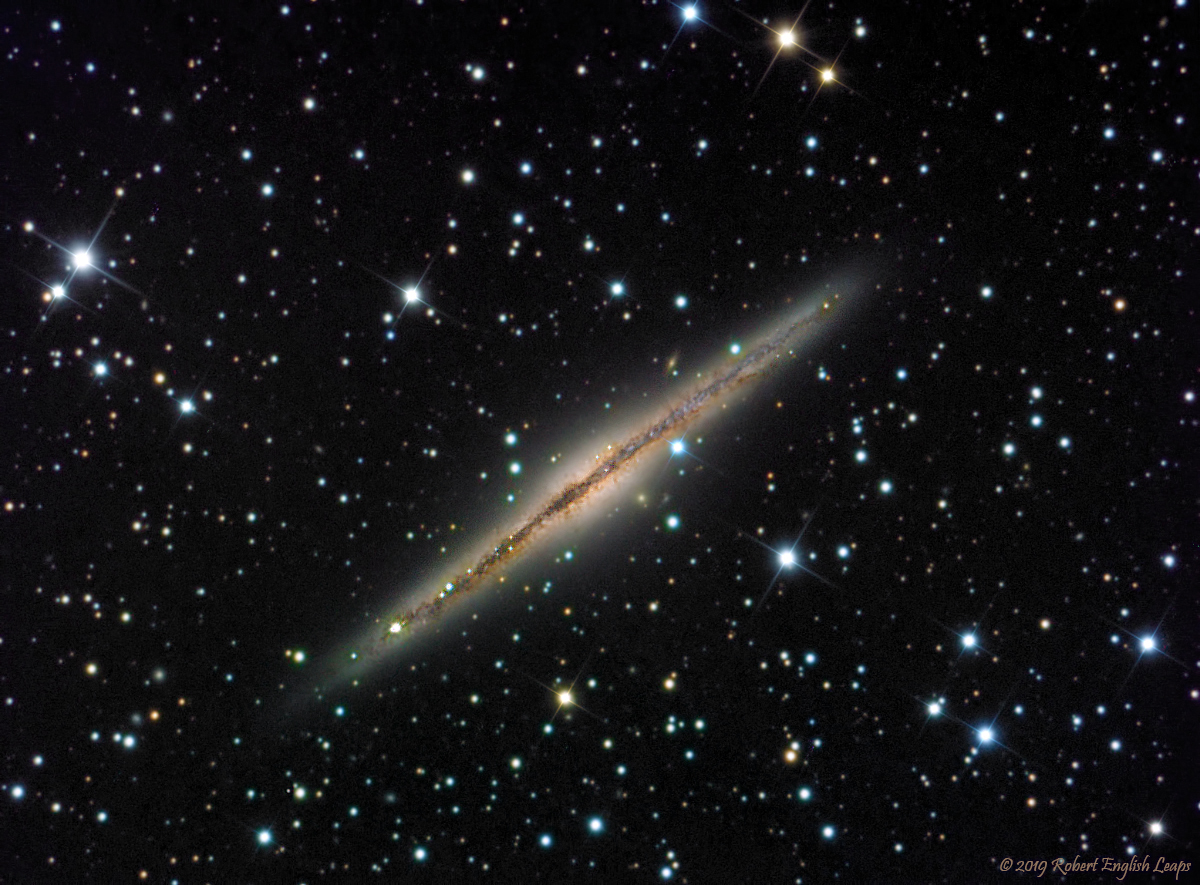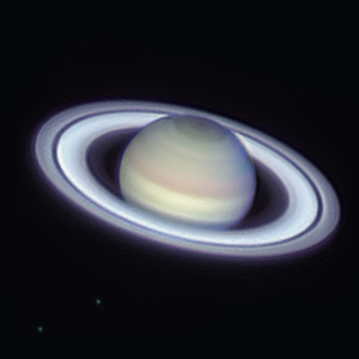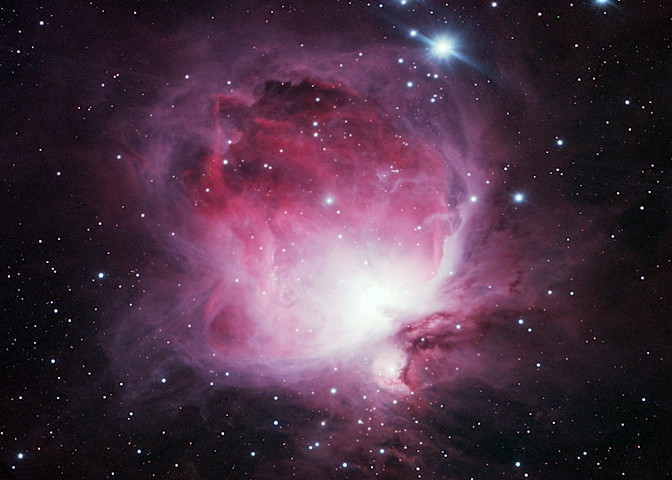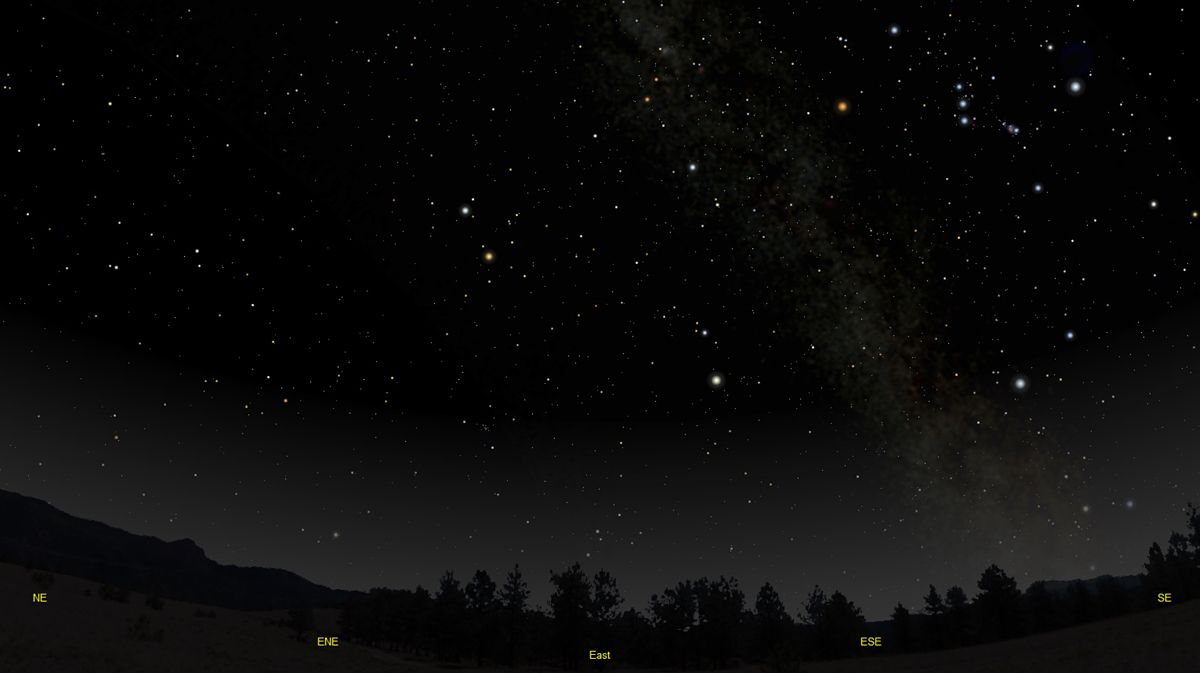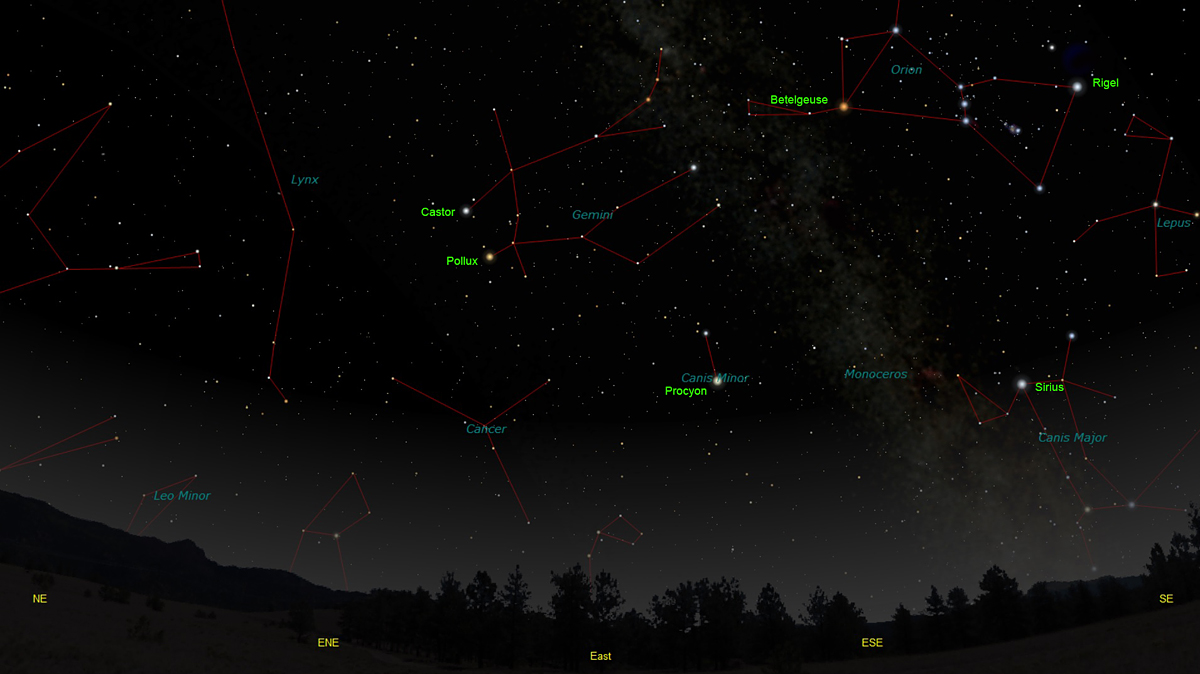The purpose of this feature is to give scout leaders, educators and naturalists an idea of some of the natural events coming up each month. We will try to cover a variety of natural events ranging from sky events to calling periods of amphibians, bird and mammal watching tips, prominent wildflowers and anything else that comes to mind. We will also note prominent constellations appearing over the eastern horizon at mid-evening each month for our area for those who would like to learn the constellations. If you have suggestions for other types of natural information you would like to see added to this calendar, let us know! Note: You can click on the hyperlinks to learn more about some of the featured items. To return to the Calendar, hit the "back" button on your browser, NOT the "back" button on the web page. All charts are available in a "printer friendly" mode, with black stars on a white background. Left clicking on each chart will take you to a printable black and white image. Though we link book references to nationwide sources, we encourage you to support your local book store whenever possible.
Notes From November 2019 One of the neatest galaxies in the fall sky is NGC 891. It's a striking edge-on galaxy east of the star Almach in Andromeda. You don't need a "Go to" mount to find it. Simply center Almach in your telescope eyepiece and, if you have a tracking motor on your telescope, turn it off. Then wait 18 minutes and 40 seconds for the revolving Earth to point you to the right spot. If you time carefully, the galaxy's position will be centered in your eyepiece's field of view.
The problem is to see the galaxy. NGC 891 is a ghost. It's surface brightness is quite low. Though it has been seen with apertures as low as 60mm under very dark skies, it usually requires a larger telescope. Even then, it appears as a very low-contrast, pale streak of light. Often you must use averted vision to see it. To use averted vision, shift your gaze towards the edge of the field of view so that the galaxy's light falls on the more sensitive rod cells in your eye. In very large telescopes you may see the dark dust lane. It's always a thrill to see the first image of NGC 891 appear on the observatory laptop during an imaging session. There is an indefinable sense of mystery about it, a sort of presence. Stephen O'Meara nicknamed it "The Outer Limits Galaxy", as it was one of several galaxies shown at the end of the first episode of that 1963 television series. All of the stars in the field are part of our Milky Way Galaxy. NGC 891 is much farther away. Latest estimates put the distance for NGC 891 at about 27 million light-years. There are many distant background galaxies that you can see in the above image if you look closely.
Sky Events for December 2019: The Geminid Meteor Shower peaks in the early morning hours and late evening hours of the 14th. A bright waning gibbous Moon will tend to diminish the shower this year.
Morning Sky: Look for Mars low in the southeastern sky before sunrise. On December 23rd you can spot it above and to the right of a waning crescent Moon about 45 minutes before sunrise. Its apparent diameter is only around 4 seconds of an arc. Mercury is visible below Mars low in the southeastern sky before sunrise during the first two weeks of the month.. Evening Sky: Jupiter, Venus and Saturn put on a pretty show this month after sunset in the Southwest. Jupiter is the closest to the horizon. Bright Venus is above and to the left of Jupiter, and Saturn is above and to the left of Venus. All three are roughly in a line. Jupiter and Saturn appear closer to the horizon each day as the month progresses, and Jupiter will disappear somewhere around the middle of the month. By the end of the month, Saturn will follow it. Venus appears higher above the horizon each day, and will appear to pass by Saturn December 10th and 11th. On December 28th, Venus will be just above a slender cresent Moon, which should be a stunning sight.
The views below show the sky looking east at 10:00pm EST on December 22nd. The first view shows the sky with the constellations outlined and names depicted. Star and planet names are in green. Constellation names are in blue. The second view shows the same scene without labels. Look for the bright stars Castor and Pollux in the constellation of Gemini, The Twins. Compare the colors of the bright stars Betelgeuse and Rigel in Orion. Betelgeuse is a red giant and Rigel is a very hot, blue-white supergiant. If you have a telescope or binoculars, look at the center of the three "sword" stars below Orion's belt. There you will find the Orion Nebula, M42, one of the most magnificent emission nebulas in the sky. The red glow of hydrogen alpha light is visible only in very large telescopes and the nebula appears as a small greenish glow in small telescopes. Crouching beneath the feet of Orion, is Lepus, the Hare. Sirius, the brightest star in the sky, shines below Orion. Sirius is in Canis Major, the Great Dog, and for that reason is known as the Dog Star. In the late summer, Sirius rises at the same time as the Sun. Because of this, the late summer days are known as the "dog days." The faint constellation Monoceros, the Unicorn, follows Orion over the eastern horizon. Low in the eastern sky below Gemini is Canis Minor, with its bright star Procyon. Procyon means, "before the dog," and refers to the fact that Procyon rises just before the Dog Star, Sirius. Look below Gemini and see if you can spot the faint glow of M44, the "Beehive Cluster." This cluster is located in Cancer, the Crab. On Learning the Constellations: We advise learning a few constellations each month, and then following them through the seasons. Once you associate a particular constellation coming over the eastern horizon at a certain time of year, you may start thinking about it like an old friend, looking forward to its arrival each season. The stars in the evening scene above, for instance, will always be in the same place relative to the horizon at the same time and date each December. Of course, the planets do move slowly through the constellations, but with practice you will learn to identify them from their appearance. In particular, learn the brightest stars (like Sirius and Procyon in the above scene), for they will guide you to the fainter stars. Once you can locate the more prominent constellations, you can "branch out" to other constellations around them. It may take you a little while to get a sense of scale, to translate what you see on the computer screen or what you see on the page of a book to what you see in the sky. Look for patterns, like the three stars in a line in Orion's belt. The earth's rotation causes the constellations to appear to move across the sky just as the sun and the moon appear to do. If you go outside earlier than the time shown on the charts, the constellations will be lower to the eastern horizon. If you observe later, they will have climbed higher. As each season progresses, the earth's motion around the sun causes the constellations to appear a little farther towards the west each night for any given time of night. If you want to see where the constellations in the above figures will be on January 22nd at 10:00 EST, you can stay up till 12:00am EST on the December 22nd and get a preview. The westward motion of the constellations is equivalent to two hours per month. Recommended: Sky & Telescope's Pocket Star Atlas is beautiful, compact star atlas. A good book to learn the constellations is Patterns in the Sky, by Hewitt-White. You may also want to check out at H. A. Rey's classic, The Stars, A New Way to See Them. For sky watching tips, an inexpensive good guide is Secrets of Stargazing, by Becky Ramotowski.
A good general reference book on astronomy is the Peterson
Field Guide,
A Field Guide to the Stars and Planets, by Pasachoff. The book retails for around $14.00.
The Virtual Moon Atlas is a terrific way to learn the surface features of the Moon. And it's free software. You can download the Virtual Moon Atlas here. Apps: We really love the Sky Safari 6 Pro. It is available for both iOS and Android operating systems. There are three versions. The Pro is simply the best astronomy app we've ever seen. The description of the Pro version reads, "includes over 100 million stars, 3 million galaxies down to 18th magnitude, and 750,000 solar system objects; including every comet and asteroid ever discovered." A nother great app is the Photographer's Ephemeris. Great for finding sunrise, moonrise, sunset and moonset times and the precise place on the horizon that the event will occur. Invaluable not only for planning photographs, but also nice to plan an outing to watch the full moon rise. Available for both androids and iOS operating systems.
Amphibians:
Recommended: The Frogs and Toads of North America, Lang Elliott, Houghton Mifflin Co. Archives (Remember to use the back button on your browser, NOT the back button on the web page!) Natural Calendar November 2019 Natural Calendar September 2019 Natural Calendar February 2019 Natural Calendar December 2018 Natural Calendar November 2018 Natural Calendar February 2018 Natural Calendar December 2017 Natural Calendar November 2017 Natural Calendar October 2017Natural Calendar September 2017 Natural Calendar February 2017 Natural Calendar December 2016 Natural Calendar November 2016 Natural Calendar September 2016Natural Calendar February 2016 Natural Calendar December 2015 Natural Calendar November 2015 Natural Calendar September 2015 Natural Calendar November 2014 Natural Calendar September 2014 Natural Calendar September 2013 Natural Calendar December 2012 Natural Calendar November 2012 Natural Calendar September 2012 Natural Calendar February 2012 Natural Calendar December 2011 Natural Calendar November 2011 Natural Calendar September 2011 Natural Calendar December 2010 Natural Calendar November 2010 Natural Calendar September 2010 Natural Calendar February 2010 Natural Calendar December 2009 Natural Calendar November 2009 Natural Calendar September 2009 Natural Calendar February 2009 Natural Calendar December 2008 Natural Calendar November 2008 Natural Calendar September 2008 Natural Calendar February 2008 Natural Calendar December 2007 Natural Calendar November 2007 Natural Calendar September 2007 Natural Calendar February 2007 Natural Calendar December 2006 Natural Calendar November 2006 Natural Calendar September 2006 Natural Calendar February 2006
Natural Calendar December 2005
Natural Calendar November 2005
Natural Calendar September 2005
Natural Calendar February 2005
Natural Calendar December 2004
Natural Calendar November 2004
Natural Calendar September 2004
Natural Calendar February 2004
Natural Calendar December 2003
Natural Calendar November 2003 Natural Calendar February 2003 Natural Calendar December 2002 Natural Calendar November 2002 Nature Notes Archives: Nature Notes was a page we published in 2001 and 2002 containing our observations about everything from the northern lights display of November 2001 to frog and salamander egg masses. Night scenes prepared with The Sky Professional from Software Bisque All images and recordings © 2019 Leaps
|
|
